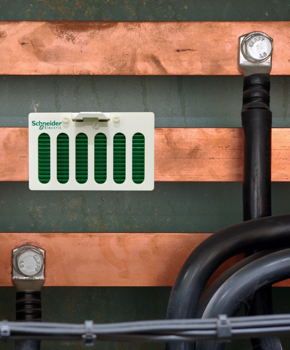Wireless busbar monitor is powered by busbar heat
![]() Schneider Electric has collaborated with a German energy-harvesting specialist to develop a wireless device that monitors low-voltage busbar systems for overheating and is powered by heat from the bars. The Qnode device avoids the need to use batteries which would require the electrical system to be switched off whenever they are replaced.
Schneider Electric has collaborated with a German energy-harvesting specialist to develop a wireless device that monitors low-voltage busbar systems for overheating and is powered by heat from the bars. The Qnode device avoids the need to use batteries which would require the electrical system to be switched off whenever they are replaced.
Loose or corroded busbar joints can lead to increased resistive heating before an eventual burnout – often during a peak load. “Such failures can stop entire production processes with millions lost each day it takes to recover,” says Fabrice Huré, Schneider Electric’s head of installed base services.
He points that that most existing technologies for monitoring busbars have drawbacks. “Manual and thermographic inspection often interferes with continuous production, it cannot be applied under full load, and leaves large periods of non-attendance. Fibre optic temperature sensors are an acceptable method of monitoring critical spots under galvanic insulation in medium-voltage applications, but are usually too costly in low-voltage switchboards. And retrofitting wired sensors in such installations would cause both prohibitive costs and downtime.”

The new device (above) is based on a chip-sized technology from the German thermoelectric specialist Micropelt that generates power from a temperature differential between the busbar and the surrounding air. The device slips over the bar and is held in place by a clamping system that adjusts to fit the busbar. If the temperature difference between the busbar and air is 5°C or more the system generates enough power to transmit a temperature reading once a second.
The compact wireless sensors are suitable for new or existing installations, and allow several points to be monitored.

